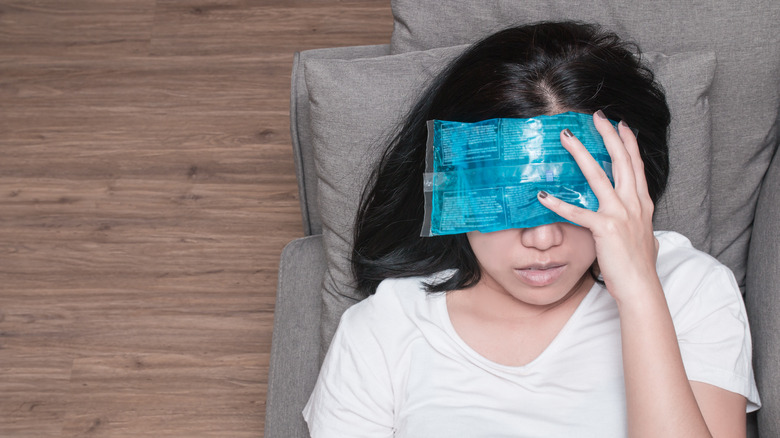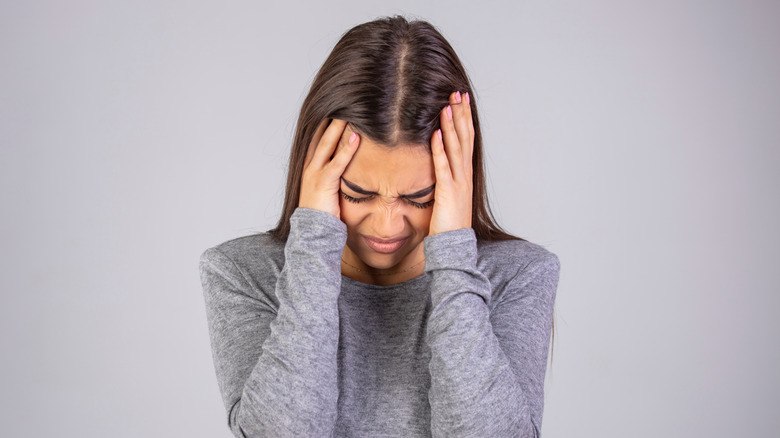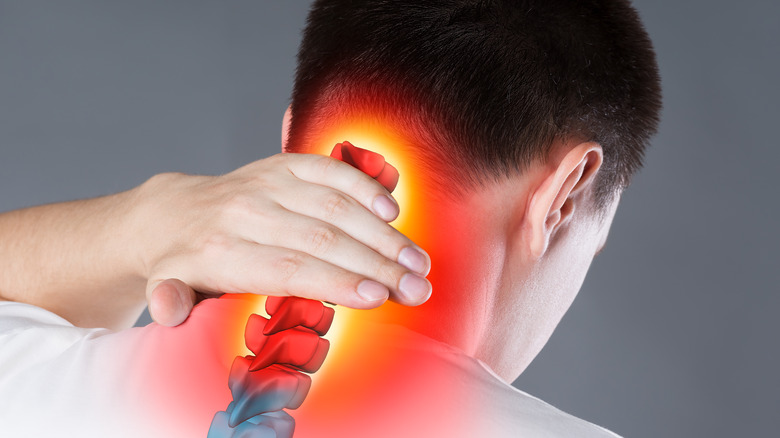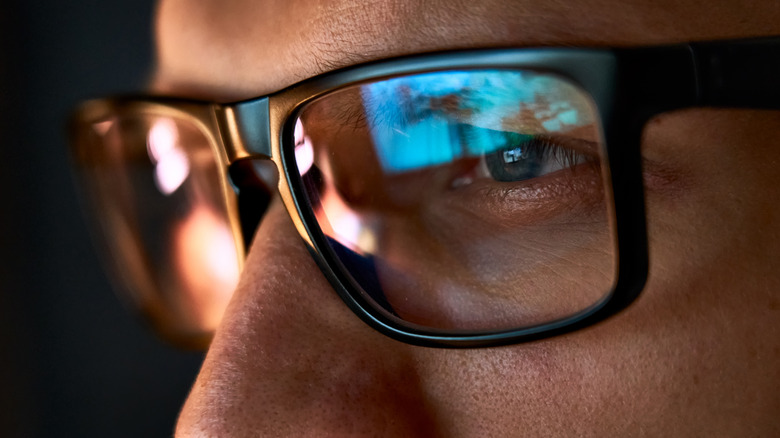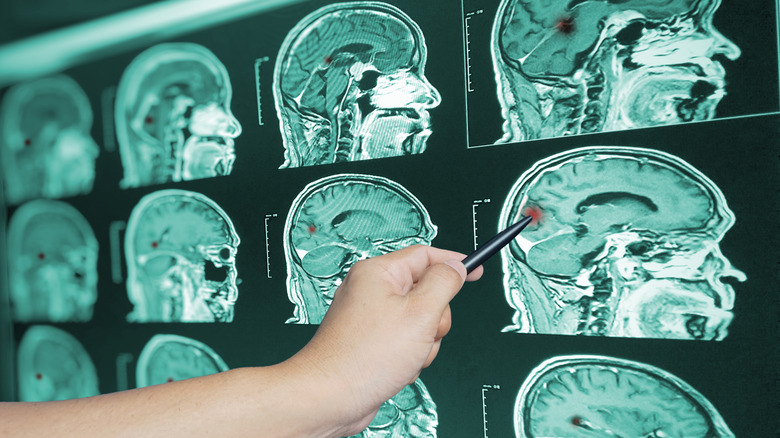Things That Could Be Causing Your Headache
You wake up one morning before your alarm goes off because your head is throbbing. Thinking that this is definitely not how you wanted to start the day, you stagger into the bathroom to raid the medicine cabinet for something — anything — to get rid of that nasty pain between your ears. Not so fast! While painkillers (when taken properly) can help with some types of pain, they aren't the cure-all for every type of headache you might experience.
As the Mayo Clinic explains, headaches are divided into two categories: primary headaches and secondary headaches. The key difference between the two is secondary headaches are a side effect of an ailment like sinus issues. Primary headaches, on the other hand, are either the ailment, itself, or a major aspect of the ailment and include migraines and tension headaches. So, treating a headache that's only a symptom of a health problem doesn't address the health problem itself and is like putting a small bandage on a gushing wound.
If you do experience headaches often, you should keep a journal and track things like when they occur, how painful they are, and how long they last, as well as what you were doing prior to the start of your headache. Yes, there are a variety of possible culprits when it comes to the root cause of headaches, so it's important to be aware of them. That way, you can recognize possible pain patterns in your life. To alleviate some types of headache pain, try these tricks.
Sudden movements could be the culprit
Imagine this: You're standing at a bus stop, when you suddenly hear someone scream. Your head quickly jerks in the direction of the sound. Moments later, everything seems fine. The person who screamed was just happy because she bumped into an old friend. But you suddenly feel sharp, jolting pain around your left eye. It only lasts for a few seconds, but you're still concerned.
If this has ever happened to you, then you may have experienced an ice pick headache. According to WebMD, these shooting pains that occur in the temples or eyes get their name because they feel similar to being stabbed with a sharp object like an ice pick. And like a bad horror movie, this stabbing sensation can happen at any time. In the above scenario, the reflex of jerking your head towards the sound of the scream was probably the cause of your ice pick headache since sudden movements are a common trigger for this type of brief but severe pain.
The good news and the bad news is ice pick headaches only last a short amount of time (via WebMD). On the one hand, these types of headaches are severe, and the less time a person is in severe pain, the better. On the other hand, they disappear so quickly that taking a painkiller is not helpful. So, if you regularly experience ice pick headaches, you should speak with your health care professional about preventative treatment options.
Too much screen time? Rest those eyes
In this digital age, we're all guilty of spending too much time staring at screens. Text messages, emails, e-books, or even just intensely playing a videogame can all take a toll on our eyes. But, if you think the worst that can happen is your peepers get a little dry, think again.
As Healthline explains, when you strain your eyes, you also overwork the muscles both inside and around your eyes. In other words, just like too much running will leave your legs feeling sore, too much screen time (especially if you're looking closely at the screen), will leave specific muscles in your face tired and aching. And remember, it isn't only screens that can have this affect. If you squint while reading a book, for example, you could trigger muscle spasms in your face, which can lead to a headache.
Fortunately, eye-strain headaches usually go away once you give your eyes a rest (via Healthline). Another sign that your headache is from overusing your eyes is you might experience short-term blurry or even double vision. In addition, you might experience some pain in other parts of your body like your neck and shoulders. To avoid eye-strain headaches, give yourself periodic breaks from your screens, and don't ignore possible symptoms like vision issues and soreness around or behind your eyes. Remember, pain is a warning signal from your body, so take it seriously and take a break.
Arthritis can also give you headaches
Usually when we think of arthritis, we imagine someone experiencing pain in their hands. But this inflammation can happen throughout the body. And, unfortunately, if you're unlucky enough to have it in your upper spine, you could experience cervicogenic headaches, according to Medical News Today.
Quick bio lesson: your spine is made up of 33 stacked bones called vertebrae (via Cleveland Clinic). Arthritis and other health issues involving these bones (specifically the ones located at the top of your spine) can cause problems with your neck (via Medical News Today). Like a chain of dominos, your neck's distress can trigger a headache that can last hours or even days. And, there's more bad news.
Cervicogenic headaches can cause pain in your shoulders or arms, as well as vomiting and blurry vision (via WebMD). Typically, the pain from this type of headache is steady rather than throbbing and concentrates on one side of your face or head. And you may feel that sneezing, coughing, and even breathing worsens your discomfort. Besides arthritis in your upper spine, neck injuries can bring on a cervicogenic headache (via Medical News Today). So, certain types of jobs like drivers and hair stylists are more likely to develop this condition because they're more likely to strain their necks. Other possible triggers include infections, tumors, and fractures, so if you think you may be experiencing this type of a headache, see your health care professional.
Pause on the painkillers
When a headache strikes, the first thought most of us have is, "How do I get rid of this thing?" Not only are they unpleasant, but they can cut into your day and interfere with your job and your social life. So, a seemingly quick fix like taking a painkiller might sound like a good solution. But, sorry to say, there is a type of headache that's actually caused by these medications.
As WebMD explains, over-the-counter, or OTC, drugs can trigger a rebound headache. How? One big issue is when someone ignores the instructions that either come with the medication or from their doctor. Yes, your doctor may have special recommendations for you about OTC treatments. Another major problem is taking large amounts of these drugs. In either case, a person could experience withdrawal symptoms (like a headache) when the drug wears off. This can lead to using more of the medicine, which can spiral into an unhealthy cycle.
Medicines that are known to cause rebound headaches include acetaminophen (Tylenol), ibuprofen (Advil), Bayer, Excedrin, and aspirin (via WebMD). Other types of drugs that can trigger rebound headaches range from sedatives and prescription narcotics to medications for treating migraines. And, if your medicine contains caffeine, it's more likely to be the source of a rebound headache. If you have concerns about any medication, speak with your health care professional. They may be able to suggest alternate treatments.
Dairy products could be guilty
Does food really cause headaches? The answer is a bit complicated. Usually, the scientific community conducts controlled studies to determine if something is fact or fiction. However, as the Cleveland Clinic explains, the possible connections between foods and headaches come not from formal research but directly from the patients. In other words, over the years, people have said that they get a headache after eating a particular food. This has led to patterns that put food as the cause of headaches in the "very probable" category.
Among the foods that could cause headaches are cultured dairy products like yogurt, sour cream, and buttermilk (via Cleveland Clinic). Another often reported offender are aged cheeses like parmesan, feta, mozzarella, cheddar, blue cheese, Swiss, muenster, brie, English stilton, and gorgonzola. However, how sensitive someone is to a particular food or group of foods varies from person to person. So, it is possible that one person could enjoy some of these dairy products without getting a headache while someone else may have to avoid all of them.
If you suspect food is a headache trigger for you, keep a food journal (via Cleveland Clinic). If you notice you get a headache 20 minutes to two hours after eating a particular food on a regular basis, you should share that pattern with your health care professional. Remember, other factors could be at work here, such as a family history of headaches, so don't leave them out of the loop.
Caffeine -- too much is never a good thing
When it comes to headaches, caffeine is a double-edged sword. Yes, it's true that some painkillers used to treat headaches contain caffeine (via WebMD). Why? Because caffeine makes the medicine work faster. However, as Medical News Today explains, too much caffeine can give you a headache.
According to Medical News Today, drinking four cups of coffee (400 milligrams of caffeine) can trigger a headache in some individuals. But, if you think cutting caffeine out of your diet is the solution, think again. While reducing how much caffeine you consume could help with headaches, it also can cause withdrawal symptoms, including nausea, irritability, fatigue, and migraine-like headaches. As Healthline notes, caffeine narrows blood vessels located in your head. No caffeine means your blood vessels get wider, and blood flow increases, which can give you a headache.
Even if you're not constantly filling and refilling your Keurig, Johns Hopkins Medicine has found that drinking just one cup of coffee a day can be enough to become dependent on caffeine (via Healthline). Once you're physically dependent, you can experience a withdrawal headache if you try to cut back on your daily caffeine consumption. If you want to "decaffeinate" yourself, there are ways to reduce your withdrawal symptoms. Peppermint oil applied directly to your forehead and temples can help with headache pain, and staying hydrated may reduce your chances of developing a headache.
Break out those shades!
Vampires and sunlight usually don't mix (unless you're Edward Cullen from "Twilight"). In many stories involving these creatures of the night, sunlight is painful and dangerous, so they fear it. But, while vampires have a phobia towards sunlight, some human beings literally have photophobia, reports the National Headache Foundation. And, no, despite the name, they don't fear light, but that doesn't mean they can't experience severe headaches because of it.
According to the National Headache Foundation, if you have photophobia, then both natural light and artificial light like from electronic screens and fluorescent bulbs, can give you migraine-level headaches. This is, in part, because of the brightness of a particular light source. For example, the sun's rays reflected off snow can be very intense and even blinding. However, the color of the light is also an important factor when it comes to photophobia. Blue-green light, in particular, is more likely to trigger a headache than other shades. And, guess what? Every type of light mentioned above, including sunlight, is a source of blue-green light.
While there isn't a specific medication for treating photophobia, the National Headache Foundation's website suggests wearing special tinted glasses to reduce the impact of blue-green light. So, if you have photophobia, you may want to speak with your eye doctor about your headaches and protective eyewear like precision-tinted FL-41 lenses. Cutting down on screen time may also help reduce the frequency of your headaches.
Beware the thunderclap
Let's be clear. We are not telling you to stop practicing good hygiene. After all, not showering can have some unpleasant consequences. With that said, it is possible to trigger a rare type of possibly-life-threatening headache when you step into your shower or bathtub (via WebMD).
Known as a thunderclap headache, this is a serious medical issue that could be warning you of a bleeding in or around your brain (via WebMD). Like a migraine, symptoms can include vomiting and nausea, as well as severe pain. However, while migraines develop gradually, thunderclap headaches happen without warning and instantly get your attention (like a clap of thunder during a storm). Quickly entering a warm or hot shower or bath can bring one on, leaving you in intense pain for about five minutes.
Even though thunderclap headaches only last a short amount of time, get emergency help immediately if you have one (via WebMD). Besides the possible dangers of bleeding in the area around your brain (or in your brain itself), you could also have a seizure as a side effect of one of these headaches. Other symptoms of a thunderclap headache include running a fever, feeling weak and confused, and experiencing changes in your vision. Also, be aware that some drugs (both legal and illegal), as well as physical activity, can trigger these extremely painful headaches.
Dehydration is often the cause
If you put a red grape in the sun, it will eventually shrivel up into a raisin. And, if you were to compare that raisin to another red grape, it would be noticeably smaller since it no longer has juice in it. Now, keep that image in mind as you read about dehydration and headaches.
According to Healthline, when a human becomes dehydrated, their brain actually shrinks. When this occurs, the space between your brain and your skull increases. And like an alarm system, the pain receptors in the membrane around your brain may cause a headache (via Healthline). In fact, this type of headache can be as severe as a migraine and can come with nausea. You also may see auras and have trouble with physical activities as a result of a dehydration headache.
Fortunately, unlike the raisin, you can return your brain to its normal size and calm the pain receptors that might be causing your headache by hydrating yourself (via Healthline). You also may want to apply a cold compress or an ice pack to your head. If you're not sure if you're experiencing a dehydration headache, look for other symptoms like not needing to urinate as often as you normally do and your urine being dark in color. Other warning signs include your muscles cramping, your mouth feeling sticky, and your skin feeling cool.
Hormones give you headaches
Here's an unpleasant biological fact: Changing levels of the female hormone estrogen is a major cause of headaches for women at all points of their lives. As Healthline explains, estrogen is connected to why humans feel pain. So, when estrogen goes down, the likelihood of developing a headache goes up. And, women experience fluctuations in their estrogen levels for a number of reasons.
For example, just prior to getting her period, a woman's estrogen levels take a major plunge (via Healthline). If a woman is pregnant, she might get migraines in her first trimester. And, while she might be headache-free from the fourth month of her pregnancy on, her estrogen levels will drop dramatically after childbirth. Yet, the hormonal rollercoaster doesn't stop there. A woman who is menopausal or perimenopausal, which involves changes to her body prior to her change of life, may or may not experience migraines. However, as Healthline notes, this might have more to do with hormone replacement therapies, which can cause hormone levels to spike and drop. In addition, oral contraceptives can have the same affect and trigger migraines.
If you think hormones may be behind your headaches, then keep an eye out for other signs that your estrogen levels are in flux like acne, weakness, constipation, and pain in your joints (via Healthline). Also, you might not feel very hungry, and when you do want to eat, you may have cravings for chocolate and salt.
You're sweet enough
When we hear the word "hangover," we usually think of drinking alcohol. But according to Medical News Today, there is such a thing as a sugar hangover. And, just like it's alcohol-based cousin, this type of hangover can also give you a headache.
Now, let's clear up one important point. While consuming alcohol causes a hangover, sugar hangovers can happen if you eat too much or not enough sugar (via Medical News Today). And if you are insulin-resistant or have diabetes, then you're more likely to experience fluctuations in your blood sugar levels, making you more susceptible to a sugar hangover headache. Even if you don't have either of these conditions, you still should monitor your sugar intake and, in particular, avoid eating too much refined sugar products like traditional baked goods and sweets.
In addition to cutting back on sugary foods, be aware of how sugar can sneak into your diet in small amounts that add up. For example, how much sugar do you put in your coffee or iced tea? And, one final note: Even if you use artificial sweeteners, you might not be out of the headache woods yet. As Medical News Today notes, such sweeteners, as well as food preservatives, are common triggers for migraines.
Exercise in moderation
You're at the gym, using the rowing machine. Sure, it's challenging, but you're really getting into a good rhythm and feel like you're hitting your stride. Then it happens. Your head starts to hurt. Frustrated, you stop your workout, wondering why this seems to always happen to you.
Exercise can be one of the healthiest things we can do for our bodies. However, according to the Mayo Clinic, some strenuous exercises can give you a headache. In particular, if you are exerting yourself constantly for the duration of your workout, then you're more likely to feel the pain along with the burn. As the above example demonstrates, rowing is a common exercise headache trigger. However, you can also develop a headache from activities like swimming, weightlifting, running, and tennis.
One major word of caution when it comes to exercise headaches: If they last anywhere from five minutes to two days, they are usually an unpleasant condition that can be treated with medication (via Mayo Clinic). But, if they last several days and are accompanied by side effects like vomiting, rigidness in your neck, and double vision, they may be a warning sign that you have a serious health concern. Possible ailments that can be the real culprits behind an exercise headache include bleeding in or around your brain, an infection in your sinuses, or a brain tumor. So, if you experience any of these symptoms, speak to your health care professional immediately.
Anemia could also be the culprit
Keeping our lungs healthy is crucial since they allow us to take in oxygen. But, without red blood cells, that oxygen would never reach our organs, our muscles, and even our brains. Fortunately, our bodies are constantly manufacturing new red blood cells to circulate throughout all our systems. However, if a person is anemic, then they have low levels of red blood cells and a greater chance of experiencing headaches and a number of health issues (via Mayo Clinic).
As the Mayo Clinic explains, there are a few ways a person can develop anemia. Their body could either be wiping out a significant portion of their red blood cells or just not producing a sufficient amount of red blood cells. They also may have lost a large amount of blood due to an injury. Whatever the reasons, the symptoms for anemia can run from mild to severe, and, yes, do include headaches, as well as chest pain, an irregular heartrate, dizziness, fatigue, difficulty breathing, and coldness in the feet and hands.
If you think you have anemia, it's important to speak with your health care professional, especially since there could be underlying causes for your condition (via Mayo Clinic). For example, you may not have enough red blood cells simply because you aren't consuming enough iron, folate, or vitamin B-12. Or a health problem like cancer, kidney disease, HIV/AIDS, or rheumatoid arthritis might be throwing off your body's ability to produce red blood cells in large enough quantities.
Be careful of concussion
You and your friends are playing a friendly game of touch football when you trip and hit your head. It doesn't seem like a particularly bad fall. In fact, you're all laughing about it as they help you up. A couple of hours later, however, your head begins to hurt, and you feel nauseous. You're even having trouble maintaining your balance. Immediately, you think of falling earlier and wonder if you were hurt worse than you realized. But, if that was the case, wouldn't you have felt something before now?
Well, as Healthline points out, you can feel the effects of a concussion well after your injury. In fact, symptoms can pop up months later, and include headaches, as well as vision and memory issues. You also may experience vomiting, sensitivity to sounds and light, dizziness, and tiredness. And, while hitting your head can give you a mild traumatic brain injury (aka a concussion), you can also get one from having whiplash. Why? Because even though you may not hit the outside of your head during a whiplash-related injury, your brain may be shaken.
If someone has a concussion, Healthline warns that they also may have damage to their neck and spine. For this reason, don't try to move the person yourself (unless you have absolutely no choice). Instead call for an ambulance. Remember, EMTs are trained to move people safely without exacerbating their injuries.

